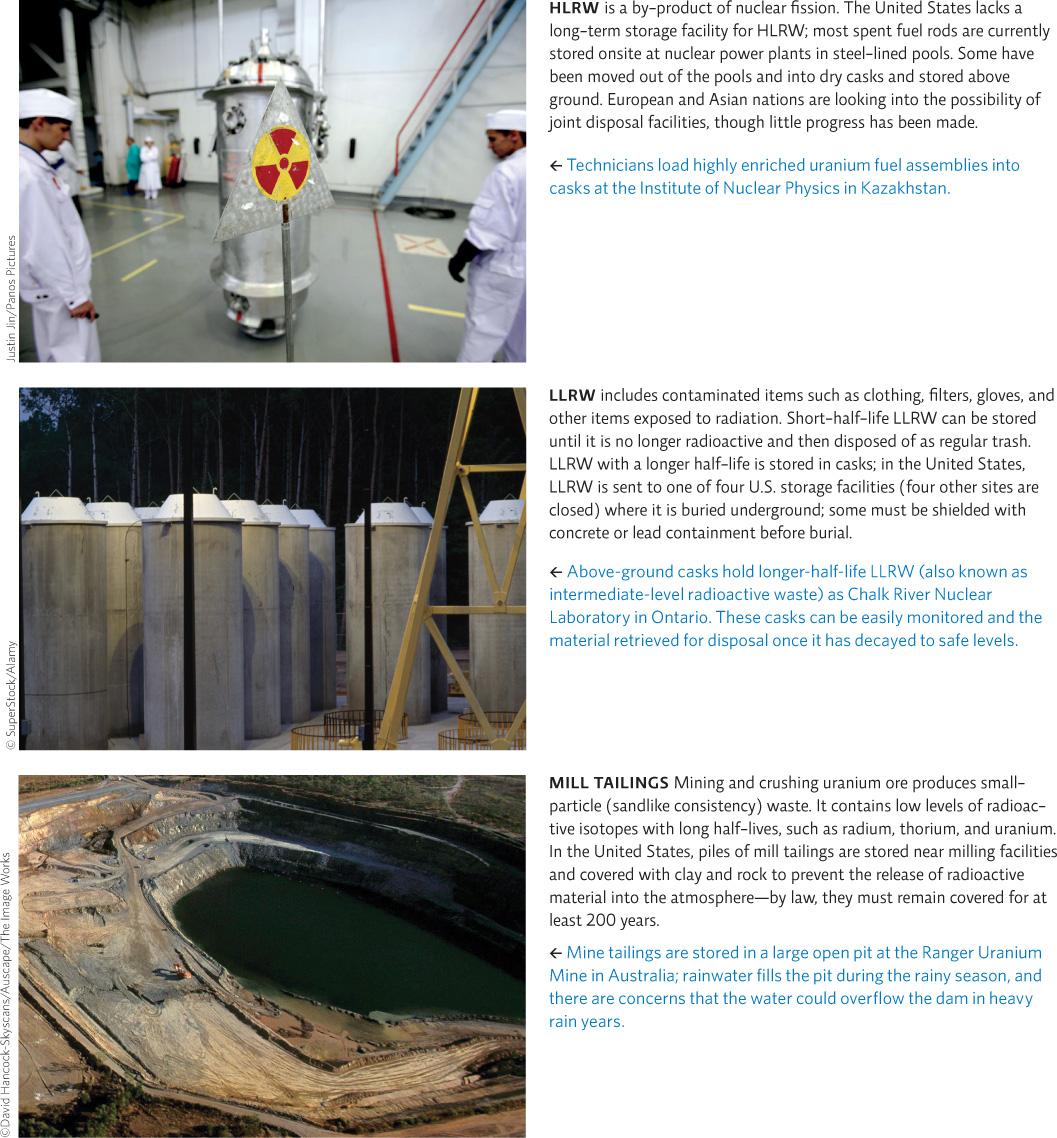The generation of nuclear waste is a particularly difficult problem to address.
The reactors weren’t the only problem. Experts around the world, especially those observing from the United States, were particularly concerned about Fukushima’s radioactive waste.
To understand why, it helps to know a little about radioactive waste. In general, there are two kinds: low-level radioactive waste and high-level radioactive waste. Low-level radioactive waste (LLRW) is material that has low amounts of radiation relative to its volume and can usually be safely buried. This includes clothing, gloves, tools, etc., that have been exposed to radioactive material. The United States produces about 60,000 cubic meters (2 million cubic feet) of LLRW per year, all of which is stored at just four sites—in South Carolina, Texas, Utah, and Washington.
low-level radioactive waste (LLRW)
Material that has a low level of radiation for its volume.
KEY CONCEPT 22.7
Radioactive waste is actually more radioactive than the original fuel. We currently have no long-term storage plan for high-level radioactive waste.
High-level radioactive waste (HLRW) is another story. As its name suggests, it’s more reactive than LLRW; in fact, because so many radioactive by-products are created in fission reactions, HLRW is actually much more radioactive than the original fuel rods. The United States produces about 2,000 metric tons (2,200 U.S. tons) of HLRW per year and has some 65,000 metric tons (72,000 U.S. tons) of the stuff in storage right now; this estimate includes both spent fuel rods and waste from the nuclear weapons we’ve produced.
high-level radioactive waste (HLRW)
Spent nuclear reactor fuel or waste from the production of nuclear weapons that is still highly radioactive.
So far, we have no safe, reliable, long-term storage plan for this waste. Spent fuel rods are stored onsite in steel-lined pools, where at least some isotopes—those with short half-lives—can decay to safe levels. Isotopes with longer half-lives require more time to reach this point. Because the isotopes produced in the fission reaction or by the decay of these isotopes are all mixed together, the waste has to be stored for as long as it takes the longest half-life material to decay to safe levels—in some cases more than 2 million years.
Almost all of the short-term storage pools in the United States are full; 55 sites are currently storing HLRW in large steel casks that are surrounded by concrete, waiting for longer-term storage options to become available. So far, we don’t have any. “Waste has been one of the biggest sore points in the debate over nuclear energy,” says Powers. “It’s the one thing we really don’t have even a good theoretical solution to.”
In 1982, 25 years after the first U.S. nuclear power plant started operation, the U.S. Nuclear Waste Policy Act was passed, assigning responsibly for nuclear waste disposal to the federal Department of Energy. The law identified deep underground storage as the best way to dispose of HLRW and established guidelines for research and development into permanent repositories. Preferred sites would be geologically stable and able to hold the waste for tens of thousands of years to allow time for the waste to decay to acceptable levels of radioactivity. Groundwater supplies should be deep below any storage tunnels to prevent water contamination from the radioactive material.
U.S. Nuclear Waste Policy Act (1982)
The federal law which mandated that the federal government build and operate a long-term repository for the disposal of high-level radioactive waste.
The United States selected Yucca Mountain in Nevada as the site for a long-term repository and began construction in 1994, but the project has been repeatedly stymied by opponents who live near the site and activists everywhere who oppose nuclear power. After 15 years and billions of dollars, President Obama halted construction in 2009, a move that fueled even more bickering. Opponents of the Yucca Mountain repository heralded the move as long overdue. But supporters argued that because the Yucca repository was authorized by an act of Congress, only Congress had the power to cancel the project. The debate promises to continue: Even if a long-term storage option is approved and constructed, we still have the problem of how to safely transport HLRW across the country—a dilemma not likely to be resolved in the near future. INFOGRAPHIC 22.7
Radioactive waste does not just come from nuclear power plants but is also generated by industry, the medical field, research laboratories, and weapons production. All of these users produce low-level radioactive waste (LLRW); nuclear power and weapons production is responsible for almost all of the high-level radioactive waste (HLRW). Though much of this material is highly dangerous and remains so for centuries, we currently have no safe way to dispose of it.


Do you think we should continue to use nuclear power, or increase its usage, if we do not have a plan for long-term storage of HLRW?
Answers will vary. Students should evaluate the trade-offs of nuclear power when answering this question.
Meanwhile, back at Fukushima, radioactive waste posed yet another deadly threat. Each of the six reactors had its own swimming pool—like container where used radioactive fuel was stored. The pools were full of years’ worth of waste, and they relied exclusively on water to prevent overheating. If just one of those pools ran dry, the consequences would be catastrophic: By some estimates, a worker standing next to a dry pool could receive a fatal dose of radiation in just 16 seconds.
On March 13, just as experts around the world were contemplating such an event, a fire broke out around the spent-fuel pool near reactor Number 4.